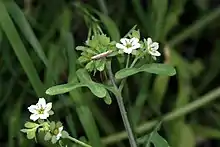| Pholistoma membranaceum | |
|---|---|
 | |
| Scientific classification | |
| Kingdom: | Plantae |
| Clade: | Tracheophytes |
| Clade: | Angiosperms |
| Clade: | Eudicots |
| Clade: | Asterids |
| Order: | Boraginales |
| Family: | Boraginaceae |
| Genus: | Pholistoma |
| Species: | P. membranaceum |
| Binomial name | |
| Pholistoma membranaceum (Benth.) Constance | |
Pholistoma membranaceum is a species of flowering plant in the borage family which is known by the common name white fiesta flower.
It is native to western North America from central California to Baja California.[1] It can be found in many types of habitat from mountain ravines to beaches to desert scrub generally below 4,500 feet (1,400 m) elevation.[1]

Description
Pholistoma membranaceum is an annual herb with a waxy, fleshy, bristly stem up to 90 centimeters long and branching profusely, sometimes forming a tangle. The leaves are deeply lobed or cut and borne on winged petioles. The foliage is coated in hairs.[2]
The inflorescence consists of cymes of 2 to 10 flowers each under a centimeter wide. Each pedicel is 5–20 millimetres (0.2–0.8 in). Calyx lobes are oblong and 1–3 millimetres (0.04–0.12 in). The flower is white, usually with a purple spot or streak on each of its five lobes.[2]
References
- 1 2 Sullivan, Steven. K. (2018). "Pholistoma membranaceum". Wildflower Search. Retrieved 2018-07-06.
- 1 2 "Pholistoma membranaceum". in Jepson Flora Project (eds.) Jepson eFlora. Jepson Herbarium; University of California, Berkeley. 2018. Retrieved 2018-07-06.
External links
 Media related to Pholistoma membranaceum at Wikimedia Commons
Media related to Pholistoma membranaceum at Wikimedia Commons- Pholistoma membranaceum — UC Photo gallery